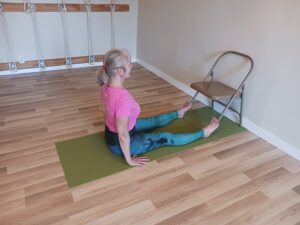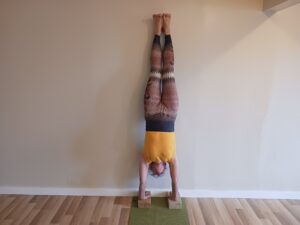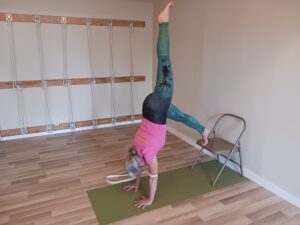 The yogic principle of ahimsa is traditionally translated as non-harming but could also be translated as love. On and off the yoga mat, love or non-harming of self comes first. As we clear the pathways in our body for the energy to flow with our yoga practice, our heart may also be purified. It is from the heart that courage can spring. Courage to step forward and create change in our lives with love and discipline. Discipline, also known as tapas in the yogic tradition, gets a bad rap. What if another word for discipline was devotion and that devotion was to yourself? Sometimes, self-love would say to indulge in that special treat or time for yourself. And sometimes discipline or devotion would say I don’t need that treat today or I need to go to bed early instead of doing one more task on the to do list. It is a razor’s edge, when you live from a yogic perspective of balance or moderation, knowing when to maintain healthy boundaries for self-care and when to do what is possible for family, friends or community. Yoga and life require willingly challenging the boundaries of our comfort zone to create healthy change. For some people that may mean doing more and for some that may mean doing less. Growth requires knowing my conditioning, habits and nature to operate with awareness and make wise choices. It takes courage to change and my courage is an expression of my love.
The yogic principle of ahimsa is traditionally translated as non-harming but could also be translated as love. On and off the yoga mat, love or non-harming of self comes first. As we clear the pathways in our body for the energy to flow with our yoga practice, our heart may also be purified. It is from the heart that courage can spring. Courage to step forward and create change in our lives with love and discipline. Discipline, also known as tapas in the yogic tradition, gets a bad rap. What if another word for discipline was devotion and that devotion was to yourself? Sometimes, self-love would say to indulge in that special treat or time for yourself. And sometimes discipline or devotion would say I don’t need that treat today or I need to go to bed early instead of doing one more task on the to do list. It is a razor’s edge, when you live from a yogic perspective of balance or moderation, knowing when to maintain healthy boundaries for self-care and when to do what is possible for family, friends or community. Yoga and life require willingly challenging the boundaries of our comfort zone to create healthy change. For some people that may mean doing more and for some that may mean doing less. Growth requires knowing my conditioning, habits and nature to operate with awareness and make wise choices. It takes courage to change and my courage is an expression of my love.
 On the yoga mat, we can move beyond our self-imposed limitations to make the impossible possible. Sometimes we think that we lack courage because we think we must do something without feeling afraid. It’s important to know that courage supports my actions even though I am afraid. To understand your relationship with courage, pick a yoga pose that you find somewhat frightening but are able to do, such as Handstand (1). Practice this pose everyday but begin slowly. On day one, do Downward Dog pose with your hands at the wall. This is also an inversion in which the arms and legs are straight. On day two, do Downward Dog with your hands at the wall and feet together. Keep one leg on the ground and lift the other leg into the air. On day three, put the back of a chair at the wall and sit in Stick Pose (Dandasana) with your feet touching the front legs of the chair and your hands by the sides of your hips. This is where your hands will be when you practice the variation with your feet on the chair seat. Next turn around and place your hands shoulder width apart. Raise one leg and place your foot on the chair seat and then the other so your hands bear your body weight. Extend your inner arms and lift your leg bones up, keeping your feet on the chair seat. Repeat this for several days until you can hold the pose for 10 to 30 seconds. Then practice lifting one leg at a time from the chair. When you are ready to progress further in the pose, seek the help of a qualified yoga teacher.
On the yoga mat, we can move beyond our self-imposed limitations to make the impossible possible. Sometimes we think that we lack courage because we think we must do something without feeling afraid. It’s important to know that courage supports my actions even though I am afraid. To understand your relationship with courage, pick a yoga pose that you find somewhat frightening but are able to do, such as Handstand (1). Practice this pose everyday but begin slowly. On day one, do Downward Dog pose with your hands at the wall. This is also an inversion in which the arms and legs are straight. On day two, do Downward Dog with your hands at the wall and feet together. Keep one leg on the ground and lift the other leg into the air. On day three, put the back of a chair at the wall and sit in Stick Pose (Dandasana) with your feet touching the front legs of the chair and your hands by the sides of your hips. This is where your hands will be when you practice the variation with your feet on the chair seat. Next turn around and place your hands shoulder width apart. Raise one leg and place your foot on the chair seat and then the other so your hands bear your body weight. Extend your inner arms and lift your leg bones up, keeping your feet on the chair seat. Repeat this for several days until you can hold the pose for 10 to 30 seconds. Then practice lifting one leg at a time from the chair. When you are ready to progress further in the pose, seek the help of a qualified yoga teacher.

As you work with the pose, notice when fear arises and when courage helps you. The point is not to do something just because it is s cary. The point is to choose to do what is possible even though there is fear. And then the fear may transform into freedom.
Fear and fatigue block the mind. Face both, then courage and confidence flow into you.
~ BKS Iyengar
1 Judith Lasater, Living Your Yoga-Finding the Spiritual in Everyday Life. 2000, p. 44
